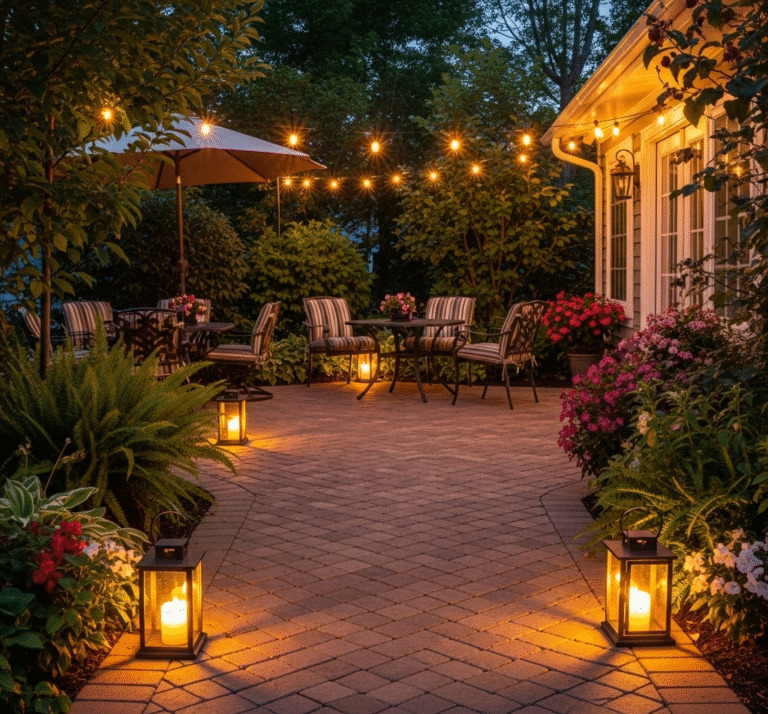Pavers vs Concrete: Comparing Durability and Aesthetics for Outdoor Surfaces

Homeowners often face a decision between pavers and concrete when planning outdoor projects. This choice can shape the look and feel of spaces like patios, walkways, and driveways. Pavers offer many benefits that make them a top pick for home improvement.
Pavers bring style and function to outdoor areas. They come in many colors, shapes, and sizes. This lets people create unique designs that match their homes. Pavers can also last a long time and are easy to fix if needed. They add value to a property and make outdoor spaces more enjoyable.
Main Benefits
Pavers have several advantages over concrete. They come in many colors and designs, giving homeowners more options to create unique outdoor spaces. Pavers are stronger and easier to fix than concrete. If one paver breaks, you can replace just that piece instead of redoing a whole area.
Pavers are safer too. They don’t get as slippery when wet and stay cooler in hot weather. This makes them good for pool areas. Pavers also help the environment. They let more water soak into the ground and don’t trap as much heat as concrete.
While pavers cost more at first, they can save money over time. They need less upkeep and can make a property more valuable. Pavers often look nicer and last longer than plain concrete.
Paving Stones and Solid Surfaces
Stone and Brick Options
Paving stones come in many forms. Natural stone, brick, and concrete are popular choices. Each type has its own look and feel. Natural stone pavers give a fancy touch. Brick pavers have a classic style. Concrete pavers are strong and come in many colors.
Paving stones offer lots of design choices. You can make cool patterns like herringbone or circles. This lets you create unique paths or patios. You can mix different sizes and colors of pavers too.
These stones have many textures and colors. Some are smooth, others are rough. Colors range from earth tones to bright shades. This helps match or stand out from your house’s style.
Poured Surfaces
Poured surfaces like concrete are simple and practical. They create one big, flat area. This can look very clean and modern.
While often gray, concrete can be more than that. It can be colored to match your taste. Stamps can make it look like other materials. It can mimic stone, brick, or even wood.
Real-Life Uses
Let’s think about two different outdoor spaces. One could use warm, reddish paving stones in a random pattern. This would give a cozy, old-world feel. Another might use large, smooth concrete slabs. This would create a sleek, modern look.
Pavers work well for:
- Winding garden paths
- Fancy pool decks
- Cozy patios
Concrete is good for:
- Big driveways
- Simple walkways
- Modern outdoor spaces
Both materials have their good points. Pavers offer more design choices. Concrete gives a smooth, even surface. The best pick depends on what you want your space to look like and how you’ll use it.
Stunning Looks and Design Freedom
Stamped concrete offers a wide range of visual options. It can mimic pavers, brick, or natural stone. Staining adds color variety, from subtle earth tones to bold hues. Stenciling creates intricate patterns. These techniques allow for custom designs that match any style. Exposed aggregate finishes provide texture and interest. The result is a walkway that enhances your property. Stamped concrete combines beauty with versatility, creating eye-catching outdoor spaces.
2. Long-Lasting and Tough
Pavers stand up well to wear and tear. They can handle big changes in temperature and heavy weights without breaking. This makes them last a long time and keep looking good.
Pavers don’t crack easily like concrete often does. They stay strong even when lots of people walk on them or cars drive over them. This strength makes pavers a smart choice for busy areas.
• Resist temperature changes • Hold up under heavy loads • Keep their looks over time • Work well in high-traffic spots
Picking pavers means choosing a surface that will stay nice for many years to come.
3. Easy Upkeep and Fixes
Pavers are simple to maintain and repair. If one paver gets damaged, it can be replaced quickly without affecting the rest of the area. This keeps the space looking good all the time. On the other hand, fixing concrete is often tricky and noticeable. Cracks or damage in concrete usually need a lot of work. This can disrupt how the area looks and might not match well with the rest. Pavers offer less disruption and a smooth finish, keeping the beauty of the space intact. Weeds can grow between pavers, but they’re easy to remove. Regular cleaning and sealing help keep pavers in top shape.
4. Safety Features
Pavers provide better grip and don’t get as hot as other materials. This makes them a good choice for areas around pools. The textured surface helps prevent slips and falls. People can walk on pavers more comfortably without burning their feet on hot days.
5. Environmental Benefits
Permeable pavers offer eco-friendly advantages. They allow water to seep into the ground, cutting down on runoff. This helps protect local waterways and replenishes groundwater. Concrete, on the other hand, creates more runoff issues.
6. Concrete vs. Pavers: Which Costs Less?
Concrete often has a lower price tag at first. This makes it tempting for people who want to spend less money right away. But thinking about costs over time is important too.
Pavers might cost more to put in at the start. But they can be cheaper in the long run. They don’t need as much upkeep as concrete does. This means less money spent on repairs and maintenance.
Pavers can also make a property look nicer. This could raise the value of a home if the owner wants to sell it later. So while pavers might cost more now, they could pay off in the future.
When picking between concrete and pavers, think about both current and future costs. Look at how much you’ll spend on upkeep over the years. Also consider how each option might affect your home’s value.
| Factor | Concrete | Pavers |
|---|---|---|
| Initial cost | Lower | Higher |
| Maintenance | More frequent | Less frequent |
| Home value impact | Minimal | Potentially higher |
7. Setting Up Your New Paver Surface
The installation of pavers takes time and skill. Experts start by preparing the area, which includes digging and leveling the ground. They then add layers of materials to create a strong base. Next, they carefully lay each paver in place. The whole process can take several days to a week, depending on the size of the project. While it may seem long, the result is a beautiful and long-lasting driveway or patio that enhances your home’s look.
8. Boosting Property Worth and Visual Appeal
Paver installations can greatly enhance a home’s exterior look. They often make properties more attractive to potential buyers. This can lead to a higher resale value compared to standard concrete surfaces. Pavers add a unique touch that stands out in neighborhoods.
Custom Patio Designs
Paver patios offer endless possibilities for personalization. Choose from various colors, shapes, and sizes to match your style. Create unique patterns or borders to make your outdoor space stand out. Pavers allow for creative outdoor designs that concrete can’t match. Mix different textures and materials for added visual interest.
10. Adapting to Different Weather
Pavers show impressive flexibility when it comes to changing weather. They can handle both very cold and very hot temperatures without breaking. This is because of how they fit together, allowing them to expand or shrink as needed.
In places with freezing winters or hot summers, pavers are a great choice. They stay looking good and working well all year long. This makes them better than some other materials that might crack or lift up in extreme weather.
Common Questions About Pavers
How long do pavers last? Pavers can stay in good shape for many years if taken care of properly. They often last longer than concrete because they don’t crack as easily and can be fixed without much trouble.
Are pavers better for the environment than concrete? Yes, pavers are a greener choice. They let water soak through, which helps reduce water runoff and keeps areas cooler than concrete does.
Can pavers match my home’s look? Yes! There are many colors and styles of pavers to pick from. This makes it easy to find ones that look good with your house.
Does it take longer to put in pavers than concrete? Putting in pavers takes more time than pouring concrete. But the extra time leads to a stronger and prettier finished product.
Will pavers make my home worth more? Installing pavers can boost your home’s value. People who might buy your house often like how pavers look and how long they last.
When getting estimates for paver installation, ask about:
- Total cost of materials and labor
- Expected timeline for the project
- Warranty options
- Maintenance needs
Final Thoughts
Pavers offer a unique blend of style and function for outdoor spaces. They provide more design options than concrete, allowing homeowners to create custom looks. Pavers also tend to last longer and are easier to repair if damaged. Their eco-friendly nature and ability to boost property value make them an attractive choice. For personalized advice on transforming outdoor areas, consulting with paving experts can be helpful. With the right approach, a paver patio or walkway can become a beautiful and lasting addition to any home.






